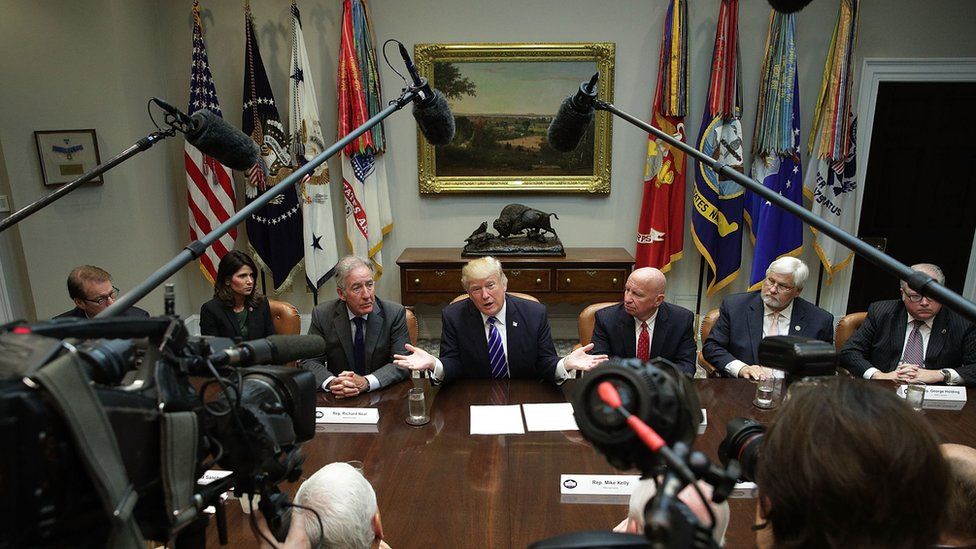Trump outlines major tax cut plans
- Published

US President Donald Trump has called for major tax cuts as part of a longstanding Republican effort to overhaul the US tax system.
A framework released by Republicans calls for lowering the tax rate for corporations from 35% to 20%, among other changes.
The president said the revamp will make the US more competitive and help middle class families.
Democrats criticised the plan as a give-away for the wealthy.
The Republican blueprint does not detail what tax benefits might be eliminated to offset the cost of the cuts for businesses - negotiations that will be difficult.
Republican leaders presented a united front on Wednesday, pledging to make changes this year while they control both the White House and Congress.
The party is looking for a win, after repeatedly failing to reform the US healthcare system.
"This is the right tax cut, and this is the right time," President Trump said at a speech to rally support for the effort.
What cuts are in the Republican tax plan?
For businesses:
- Reduce corporate rate from 35% to 20%
- Change tax on overseas profits, with details unclear
- A top 25% rate for firms organised as "pass-through entities", such as limited liability corporations
For families:
- Nearly double the amount individuals and families can deduct to $12,000 and $24,000
- Increase tax credit for children
- Introduce a new tax credit for non-child dependents
- Eliminate a tax on inheritances
'Talking the talk'
Democrats said the proposal will hurt middle class families, particularly lower-income, single parents with children.
The plan would slim the number of tax brackets to three - with people charged at a 12%, 25% or 35% rate.
Currently, the bottom rate is 10% and the top rate is close to 40%.
What incomes would qualify for each rate is still unknown.
White House officials said the proposal leaves open the possibility of a higher top rate.
They also said bigger deductions would make up for the higher bottom rate, and the elimination of other personal exemptions.
Senator Chuck Schumer of New York, a top Democrat, dismissed that claim as 'bunk'.
Deficit-financed cut
He also said the cuts would increase the deficit, putting entitlement programmes such as Medicare and Social Security at risk.
The Committee for a Responsible Federal Budget, a nonpartisan think tank, said a rough analysis suggests the proposal would lead to $2.2tn in net cuts over about a decade.
The Trump administration maintains that closing loopholes will help offset revenue loss. Among the benefits that would be eliminated are deductions for state and local taxes.
Lawmakers plan to preserve tax incentives for homeownership, retirement, education, as well as research and development.
President Trump said the lower tax rate for business will spur growth, helping to cover the cost.
Economists maintain that growth will not be enough to close the gap. They expect the plan to add to the US debt, which has already passed $20tn.
"It is clear that much more work needs to be done to ensure tax reform is fiscally responsible," the Committee for a Responsible Federal Budget said. "Given today's record-high levels of national debt, the country cannot afford a deficit-financed tax cut."
Analysis by US business correspondent Michelle Fleury
In Indiana, Donald Trump promised "revolutionary change" to America's tax code.
The last time it was overhauled was when Top Gun was released in cinemas and the Oprah Winfrey Show made its TV debut. Ronald Reagan was president and the year was 1986.
Today, few would argue against simplifying the nation's tax system. But does this plan achieve that reform?
The blueprint released by the White House and Republican congressional leaders offers plenty of ideas for cutting taxes - for individuals and for corporations.
However, it leaves many questions unanswered.
It does not specify which tax breaks should be removed to make up for the trillions of dollars in lost revenue.
Calling the current plan "tax reform" may be pushing it too far.
Cutting taxes is easy. Identifying ways to pay for it is the real challenge.
- Published13 September 2017
- Published30 August 2017
- Published30 August 2017
- Published26 April 2017